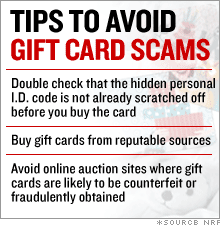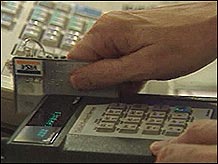Watch out for holiday scams and fraudCrowded stores and busy employees make the holidays a fertile period for shoplifting, ID theft, refund fraud and gift card scams.NEW YORK (CNNMoney.com) -- Most people think the holiday shopping season is about the big crowds and big bargains. But there's one more seasonal hallmark that doesn't always get its fair share of publicity - big holiday crimes. While retail crimes such as shoplifting, ID theft, returns fraud, gift card scams and organized retail theft are a year-long nuisance for merchants, industry experts caution that offenders tend to kick up their activities a couple of notches during the busy year-end gift-buying months.
"It's fairly obvious why that happens," said Chris McGoey, a professional security consultant and an expert on loss prevention who has been a consultant for some of the nation's biggest retail chains. "The store staff is too distracted with the crowds, and shoppers are too busy hunting for bargains and aren't particularly vigilant," he said. According to a 2005 National Retail Security Survey prepared by the Center for Studies in Criminology and Law at the University of Florida, in partnership with the National Retail Federation (NRF), retail crimes last year cost the industry more than $37 billion dollars. However, the report also pointed out that employee theft continues to be the main source of lost inventory for retailers, accounting for almost $18 billion in 2005, followed by shoplifting which cost merchants $12.2 billion, administrative error which cost sellers $5.5 billion and vendor fraud which accounted for $1.9 billion in lost sales. Organized retail theft is growing problem for retailers. It's always been around, but the creation of eBay (Charts) has only exacerbated the problem, McGoey said. This activity involves a "gang" of people who steal entire shelves of products such as beauty care items, baby food and trendy jeans - not for their own personal consumption, but to resell them for a pretty profit. "These criminals will create some disturbance in one part of the store to distract the staff, or even light a small fire in the restroom," said McGoey. "Usually dishonest employees are involved in the process. If they sell the items on the street they get 10 cents on the dollar. On eBay, they can get up to 50 percent of the value." Also, retailers tend to hire more temporary workers during the holidays to deal with the traffic surge. "Most of these workers aren't carefully screened. This contributes to activity like embezzlement or unfairly giving family members store discounts," he said. Retailers are trying to counter the problem by implementing sophisticated technology to catch perpetrators. But McGoey said companies can still do more. "Technology can't completely replace security staff. Companies like Wal-Mart are cutting security personnel to save costs and improve profits. This will only create loopholes for criminals," he added. Wal-Mart (Charts) did not immediately return calls for comment. How safe are the new wave systems? Have you used the new "contactless" payment systems yet? This is where you don't need to swipe your debit or credit card but instead simply wave it in front of a card reader and your payment is recorded. Todd Davis, CEO of LifeLock, an ID theft prevention company, said he's aware of a few recent incidents in which the payment systems have been targeted by hackers. "When you get in proximity of the reader, what happens is almost like a digital handshake between your card and the system," Davis said. "The retailer usually doesn't require any other form of ID from the customer." Davis said the system can be compromised if hackers successfully penetrate the system's database to get access to individual cards' security algorithms. How does this happen? "Unfortunately it often involves people on the inside. There's a black market for such information," he said. "Once fraudsters have access to it they can use your card without your knowledge." "ID theft is a $50 billion a year industry and a lot of it ends up happening at the retail level," he said. Gift card scams The NRF estimates that gift card sales will total $24.81 billion this holiday season, up from $18.48 billion last year, as many more frazzled shoppers become enamored with the convenience that gift cards offers. However, recent media reports have alerted consumers to a new gift card scam that threatens to dent their popularity. According to these reports, criminals steal the account numbers from the back of gift cards that are sold on open racks in many stores. These fraudsters then call retailers to check that the card was activated and record the balance before using the information to buy goods online. The NRF said the facts relating to this scam true, but also somewhat misleading. "Instances where consumers lose money from theft of gift card information are extremely rare, but they can happen," Joseph LaRocca, NRF vice president of loss prevention, said in a statement. "Most gift cards are outfitted with scratch-off security codes and protective packaging, in addition to a special verification number distinguishing one gift card from another," LaRocca said. "Also, retailers have created complex back-end systems to prevent criminals from obtaining proprietary gift card information." Bob Skiba, executive vice president of Stored Value Systems (SVS), one of the biggest providers of gift cards and card programs to 650 retailers, including the Gap (Charts), Home Depot (Charts) and Barnes and Noble (Charts), said consumers shouldn't be overly concerned about the latest incidents of gift card fraud. "More than 95 percent of the cards that we supply to our clients have scratch off security activation codes which only the buyer should see," said Skiba. "Also, unlike three years ago, most cards today don't carry any value until they're bought and activated by the buyer." At the same time, Skiba did acknowledge some legitimate scams consumers should know about. One involves gift cards that are sold in decorative cardboard envelopes where the card barcode appears on the packaging rather than on the card. "The thieves remove the card from its envelope and pockets it. Then they replace the missing card with a card from another package," Skiba said. Subsequently, an unsuspecting shoppers picks up the first envelope with the card and buys it. But because the barcode was on the envelope, and not on the card itself, the shopper goes home with an inactive card, while the shoplifter now has a useable gift card in his or her pocket. Said Skiba, "We make certain that all of our cards carry their codes on the card itself and not on the packaging." To defeat gift card fraudsters this holiday season, the NRF suggests that consumers double check the section on the back of the card to make sure that the personal identification information isn't already scratched off. Additionally, consumers should only purchase gift cards from reputable sources and not online auction sites where they are likely to be counterfeit or were fraudulently obtained. Holiday gift returns: Still nothing easy about it Warm weather chills holiday sales |
|



